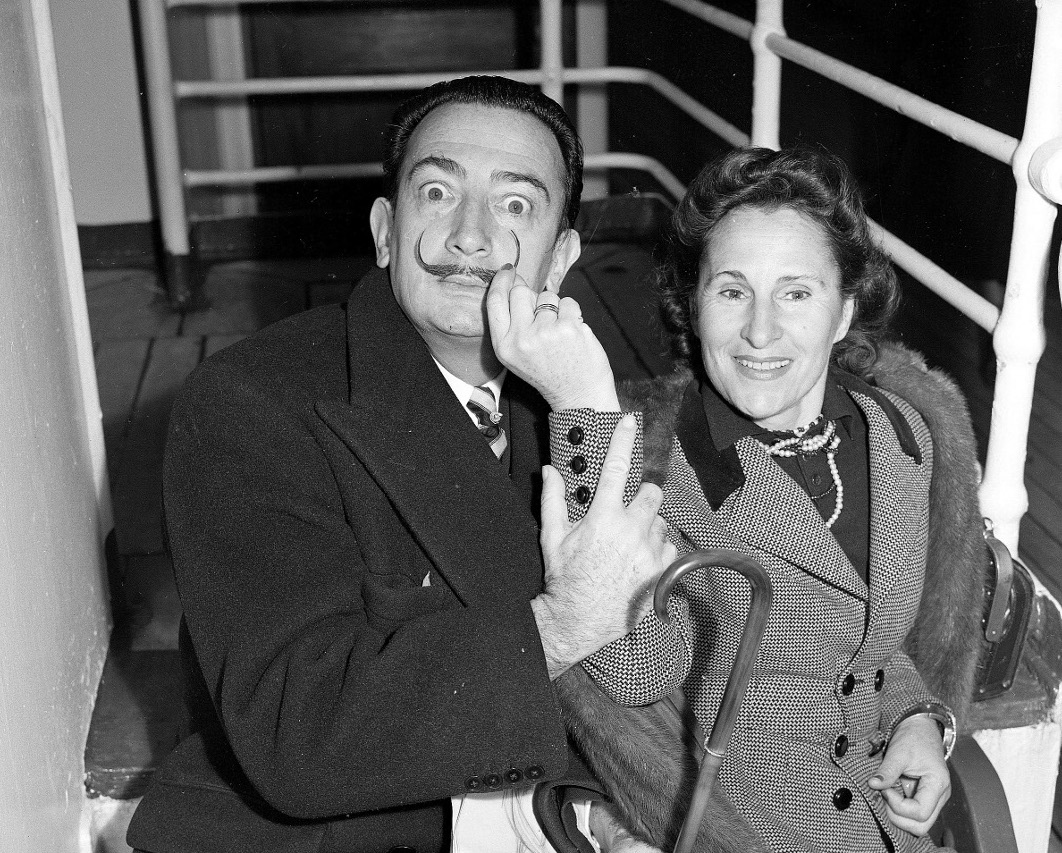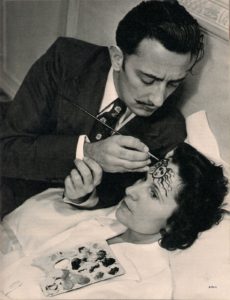On Salvador Dali’s wife Gala
When Salvador Dalí’s wife Gala died in 1982, the first person outside of his household to hear the news was Juan Carlos, the King of Spain. Dalí telephoned the reigning monarch himself, and for once, this was not an act of posturing or presumption on his behalf. By then, the once destitute artist had become a surrealist superstar, a multi-millionaire, a man whose supreme genius landed him the nickname el maestro, the title of a Marquess, endless fawning fans and an equally endless litany of clingers-on, copycats and sycophants. Dalí had met Gala, born Elena Ivanovna Diakonova, when he was at the tender age of twenty-four (and, the story goes, still virginal). She was ten years his senior and they lived together for the next fifty-three years, until her death. How would he fare without her?
Not well. Following her funeral Dalí locked himself away in his surrealist tower, in Púbol, Spain, drew the curtains and refused to eat or drink. He denied entry to his friends and aides and forbade anyone to speak Gala’s name. As he wrote in Confessions Inconfessables in 1973, the castle itself was a testament to his love:
Everything celebrates the cult of Gala, even the round room, with its perfect echo that crowns the building as a whole and which is like a dome of this Galactic cathedral. When I walk around this house I look at myself and I see my concentricity. I like its moorish rigour. I needed to offer Gala a case more solemnly worthy of our love. That is why I gave her a mansion built on the remains of a 12th century castle: the old castle of Púbol in La Bisbal, where she would reign like an absolute sovereign, right up to the point that I could visit her only by hand-written invitation from her. I limited myself to the pleasure of decorating her ceilings so that when she raised her eyes, she would always find me in her sky.
In 1984, two years after her death, a fire broke out in his bedroom under suspicious circumstances and Dalí was horribly burnt. In the hospital they discovered he was suffering from severe malnutrition and his staff was accused of negligence. But the truth, as Gala’s biographer Tim McGirk wrote in Wicked Woman, was that “after Gala’s death, Dalí lost his will to paint or even live”.
It is easy to imagine the woman who inspired such adoration and devotion from her husband as a gentle, supportive, nurturing type. A figure who posed for him and looked after him and gave him the space to cultivate his talent. The ministering angel to Dalí’s cacophonic madness. But a world in which Gala can be cast as a passive, motherly companion is a world driven crazy by patriarchy and its assumptions. At her best, Gala, born was difficult and intense. At her worst, she was nothing short of monstrous. She had no friends and maintained a malevolent distance from her family. Described as having “eyes that pierced walls”, and as “cruel, fierce and small,” she collected stuffed toys but once cooked her own pet rabbit. Her “demonic temper” asserted itself often; if she didn’t like someone’s face she spat at them, and if she wanted to silence someone she would stub cigarettes out on their arm. Not surprisingly, she was hugely unpopular. Women particularly disliked her – Gala was sexually voracious and had no respect for other people’s relationships. Dealers in Paris nicknamed her ‘Gala la Gale’ – gale means both a spiteful person and scabies. The filmmaker Luis Buñuel who, with Dalí, made the seminal short film Un Chien Andalou, got so sick of Gala’s insults that he once tried to throttle her. In a 1998 Vanity Fair article rife with gendered language that now feels blessedly dated, John Richardson, one of Dali’s art dealers in the early 1970s, refers to Gala as an “ancient harridan,” “an authentically Sadean monster,” a “demonic dominatrix,” a “scarlet woman,” and as having “an appetizing little body, and the libido of an electric eel.”
Towards the end of her life, already addicted to Dalí’s money, Gala gambled away huge sums in the underground casinos of New York. She maintained something of a male harem, a perpetual parade of young lovers, when she herself was well into her eighties. The castle itself was famously off-limits to Dalí unless he received a written invitation from Gala, an arrangement that seemed to suite them both. In the late 1970s, she became besotted with Jeff Fenholt who had played Jesus Christ Superstar in the Broadway production, and during their affair, she gifted him several Dalí canvasses and bought him a house on Long Island valued at $1.25 million. Dalí himself only found out when he saw Fenholt had put his artworks up for auction at Christie’s. Eager to keep money coming in, when her husband could no longer paint, she forced him to sign blank canvases and commissioned forgers to complete the paintings, selling them at sky-high original-Dalí prices. Consequently, dealers are often suspicious of any of the artist’s works created from the mid-60s onwards. Towards the very end, when Gala was almost certainly senile, she was medicating Dalí with concoctions of unidentified drugs, and may well have been the cause of a nervous disorder that brought on Parkinson’s disease and definitively terminated his career.
So far, a considerable list of sins. How, one might wonder, was Dalí able to love her, in his own words, “more than my mother, more than my father, more than Picasso, and even more than money”? One fact remains indisputable: Gala was not just his wife, she was his muse. He painted her as a Madonna twice, as Leda with the swan, as a nude. He produced countless portraits. When she had a hysterectomy, he painted The Bleeding Roses, which shows Gala’s familiar blonde hair and her figure with a bushel of crimson roses across her stomach, the petals of which turn into drops of blood. He thrived off her emotions, one might go so far as to say he appropriated her pains for his oeuvre. Certainly, it would be fair to say that Gala is the most recurring motif in Dalí’s work. As activist and author Germaine Greer wrote:
“A muse is anything but a paid model. The muse in her purest aspect is the feminine part of the male artist, with which he must have intercourse if he is to bring into being a new work. She is the anima to his animus, the yin to his yang, except that, in a reversal of gender roles, she penetrates or inspires him and he gestates and brings forth, from the womb of the mind.”
Gala performed some special, quasi-alchemical function, sparking Dalí’s imagination like nothing else could. But for Gala these canvases were not a matter of vanity. Her work wasn’t restricted to sitting still long enough to be immortalised in oil. Gala acted as agent, dealer, promoter and jailer; she channelled all her ruthlessness into her promotion of him. Many have argued that this was avarice on her behalf, but the truth, as always, is more complicated.
When she and a young Salvador Dalí met in Cadaqués, his hometown on Costa Brava, Gala was already thirty-four years old and the wife of celebrated surrealist poet, Paul Eluard. The Eluards were bohemian, part of café society and at the centre of artistic Paris. Their marriage was a liberal one, each party encouraged the other in affairs. For a time, Gala and Paul even lived in a ménage-a-trois with the painter Max Ernst. But despite her freedoms, both sexual and financial (Paul Eluard had been left a sizable inheritance by his father), Gala was beginning to feel bored. Having already played muse to her poet husband and his friends and mixed with their intellectual milieu, she had an understanding and an eye for art. She was doubtless looking for fulfilment, but she was also genuinely struck by Dalí’s talent. The trip to Cadaqués had been a sort of holiday-come-intervention, organised by her husband who dragged her along with fellow Surrealists René and Georgette Magritte and Camille Goemans. Dalí’s friends in Paris and his gallerist were awaiting works from him, but Dalí seemed to be in the midst of some sort of nervous breakdown, a “lunacy” which led him to dissolve into fits of hysterical laughter whenever he tried to speak. His friends and agents were becoming desperate; they needed him lucid. With Gala’s arrival, the group noticed a change in Dalí, and as Gala’s biographer Tim McGirk writes, they decided that “if Dalí was so besotted by Gala perhaps she alone could help him.” Their little conspiratorial plot was to send her on a “psychic rescue mission to pull him out of his madness”. Miraculously, she was able to stabilise his mood. Dalí finished the paintings necessary for his exhibition, and from then on, they barely left each other’s side.
One mustn’t underestimate the sacrifices Gala made to be with Dalí. Despite her love of money, she left her wealthy family in Paris, swapping a luxury apartment for a shack on the beach. They had no running water, no electricity, no heat and no stove. It was Gala’s job to maintain Dalí’s morale, to pose for him, to dress him, to soothe him and comfort him and to barter for bruised fruit at the market, making their few pennies stretch. If she was his muse, she was also his mother, a symbolic role which she made real by adding a sinister dimension: Gala abandoned her own child to take care of Dalí instead. Finally, it was Gala who peddled his canvases from gallery to gallery, who convinced a wealthy art patron to subsidise the lease on their shack and who, in the wake of Europe’s bankruptcy at the end of WWI, conjured up the scheme of defecting to wealthy America and selling his work there. In one particularly ingenious move, she convinced a group of aristocrats led by the Prince de Faucigny-Lucinge to “toss a yearly sum of 2500 francs into the pot for Dalí, and over a sumptuous dinner they would hold a draw, with the winner getting Dali’s newest work.” The plan was machinated to appeal to the dissolute, gambling young nobles, and of course it did. Whatever people saw as her “spitefulness,” she never had any artistic pretensions of her own and she never spoke about herself or her past, lest it should take away from the Dalí aura.
In the end, Gala profited from her ferocious championing of Dalí. She is blamed with corrupting and commercialising his art. She’s judged for being promiscuous, aggressive, single-minded and ambitious (qualities for which men are more often celebrated). More often still, she is not remembered at all. Yet without Gala, the great artist may never have been. Dalí’s imagination is often seen as a force of its own, but in reality, it was a fragile construct, unable to flourish without Gala, whom he used as a shield. Behind her, he would be safe to create; without her he would be swept away. Dalí honoured this co-authorship of his life. As early as the 1930s, he began to sign his canvases with both their names although she’d never so much as lifted a brush. “It is mostly with your blood, Gala, that I paint my pictures,” he told her.
Nina-Sophia Miralles is the founder and editor of Londnr magazine, a print and digital-culture publication based in London. She has also written for Harrods magazine and hosts a literary salon.
from The Paris Review https://ift.tt/2zrYQZ5


Comments
Post a Comment